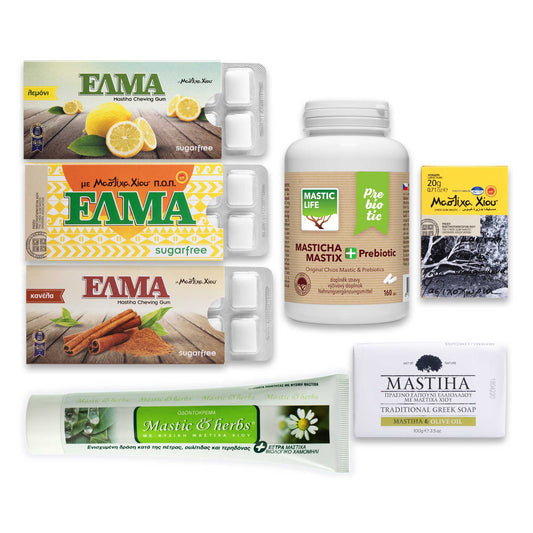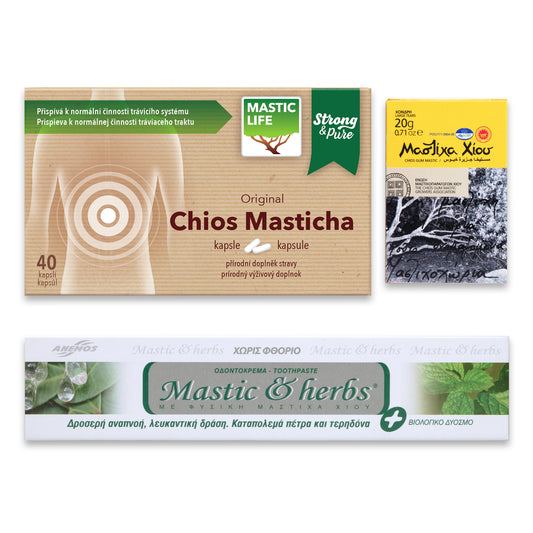What Is Mastic and Mastic Gum? The Tears of Chios
A drop of resin from a tree called mastic tree is a phenomenon that will amaze you when you see it for the first time. It is the resin of the Pistacia lentiscus tree that grows on the island of Chios. Enjoy its unique, naturally sweet and resinous taste! And its fragrance, reminiscent of pine trees and the fruits of evergreen forests. It will surprise you not only with its taste and smell, but also with its effect! This resin is connected with the rich history, the culture, the particular architecture, the organization of cultivation, the people and the landscape of a small area surrounded by the sea.
What is mastic?
Mastic of Chios (Chios Mastic Gum) is a name for the aromatic resin extracted from Pistacia lentiscus var. Chia in the southern region of the Greek island of Chios. This 100% natural BIO product is unique in many ways. It has many beneficial effects and its use and trade have a thousand year old tradition. Due to the small area under cultivation, mastic is very rare.

The secret(s) of the island of Chios
Mastic gum of Chios: a "resin drop" that delights, soothes and smells! If there was a registered trademark for the island of Chios, it would certainly be the tree that produces this resin. It is a true gift of nature, which over the centuries has often become a bone of contention between powerful rulers.
Mastic is the sap of an evergreen tree from the family Anacardiaceae, genus Pistacia lentiscus. It grows mainly on the eastern Mediterranean coast. Of this particular family of pistachio trees, only the variety Pistacia lentiscus var. Chia, is systematically cultivated in the southern regions of the island of Chios, where it produces a resin known for its beneficial effects.
The combination of the different tree species, the soil, the microclimate, the topology and the relief of this area is the "secret" of the exclusivity that characterizes this small corner of our planet.
PDO
As an absolutely unique product, linked to a specific, very small area, the mastic gum has been granted a Protected Designation of Origin (PDO).
How is mastic gum extracted?
Incisions in the tree
The production of the best quality mastic is done exclusively by hand. It is a process that takes place practically throughout the year. The most important and demanding phase of production is the notching of the bark of the trunk and the large branches during the summer months.
This natural aromatic resin is obtained in the form of drops from the notches cut with sharp tools in the trunk and large branches. The resin that flows out remains on the ground under the tree for about 20 days until it hardens. This depends mainly on the weather during the summer months. The determining factors are mainly sunlight and humidity. A fully grown lentil tree produces about 1 kg of resin per year.
Collection
The solidified raw material - the best quality mastic - is collected from the ground under the tree, which was covered with white rock for this purpose, and from the trunk and categorized according to the size of the drops (also called crystals, tears, granules), which vary from a few millimeters to a centimeter in diameter. Then the pieces are washed and cleaned.
Processing of the mastic gum
Processing and trade are consolidated in the Chios Mastic Growers' Association (Ένωση Μαστιχοπαραγωγών Χίου), founded in 1938. Individual growers from mastic villages in the region transfer the entire harvest to the association's local collector, who forwards it to the central office.
What does mastic gum look, smell and taste like?
Mastic gum is initially a clear, sticky sap that solidifies over time and takes on a yellow-brown color. The initial bitter taste becomes sweet after a few weeks. This taste, combined with a distinct aroma, is typical of mastic. The mature resin is therefore characterized by a strong woody-fruity aroma and sweet taste.
Composition of the resin
The exact composition is not yet known. This unique resin consists of a unique spectrum of active and aromatic ingredients. This combination of more than 80 substances probably explains why mastic is so widely used worldwide in food, pharmaceuticals, medicines, etc.
In particular, it contains the following substances:
- natural polymers
- volatile and aromatic substances that make up the essential oil
- terpenes, phytosterols, polyphenols
- and a number of other radical substances, some of which have been discovered here for the first time in nature
Does not contain:
- Gluten
- Allergen (see attachment)
History of Chios Mastic
Ancient
The mastic of Chios has been appreciated since ancient times for their characteristic taste and effects. Documents show that mastic was the first natural chewing gum in human history, an organic gum used to clean teeth and freshen breath.
It was even used as a cosmetic agent for cleaning the skin of the face and body. The mastic gum of Chios is also used as an active ingredient in many creams, ointments, cosmetic waters and other pharmaceutical formulations.
Dioscorides, the father of pharmacy
Dioscorides (1st century), considered the "father of pharmacology", divided all medicinal materials into 5 categories. His book "On Medicinal Materials" was surpassed only in the 16th century. In his book Dioscorides praises the properties of Chios mastic. Moreover, according to Dioscorides, chewing contributes to fresh breath in addition to oral hygiene. He also mentions the mastic oil, which is used in many areas.
The beginning of our era
In the period from the 1st to the 7th century, the resin from the Greek island is used for purposes that can not be named (due to EU regulations on dietary supplements), especially by Oribasius, Aetius, Galen and Pilen.
Middle Ages
In the following years, many pharmacists and botanists referred to the properties of the resin, which they used for purposes that could not be stated (due to EU regulations on dietary supplements). The widespread use of Chios tears continued successfully in the Byzantine period.
Modern times
In modern times, the trade in mastic flourished on the European continent. In many European writings of the 16th to 18th centuries (books containing the knowledge of the apothecaries of the time) there are extensive references proving the beneficial effects of mastic in many areas.
Present
The study of mastic gum and its effects has been the subject of clinical and laboratory studies, as well as scientific articles in international pharmacological journals.Since 2014, the method and know-how of resin cultivation has been included in the UNESCO Representative List of Intangible Cultural Heritage. Annually, about 250,000 kg of resin are exported from Chios, mainly to the EU, the USA, the United Arab Emirates, Saudi Arabia and Australia.
Benefits of Chios Mastic
- contributes to a normal gastrointestinal system
- contributes to oral hygiene
Our brand – Masticlife
Masticlife brand brings the unique beneficial properties of Chios Mastic Gum in high quality
Dietary supplements
- Under the brand Masticlife you can buy mastic powder in capsules or sachets.
- New in the offer: capsules with mastic oil with added probiotics.
| Product | Type / Form |
|---|---|
| Mastic Strong&Pure | Capsules |
| Mastic+ Prebiotic | Capsules |
| Mastic Comfort | Sachet |
| Mastic+ D3 | Capsules |
| Mastic Vital Double Action | Capsules with mastic oil + probiotics |
Mastic gum crystals
Most commonly used as chewing gum or as an ingredient in Mediterranean cuisine. All available sizes can be purchased in our e-shop:
- large
- medium
- small
ELMA chewing gum
ELMA stands for "elliniki mastiha" - Greek mastic. Under this brand you can buy chewing gums with mastic.
Toothpastes
Antibacterial effect of mastic oil in toothpastes:
Cosmetics
Hair and body cosmetics with mastic oil are very popular.
The uses of mastic
How is the mastic gum used and for what purpose?
- Resin (chewing gum, spice)
- Oil (cosmetics, oral care)
- Powder (dietary supplement)
Which mastic gum product should I choose?
- If you just want to enjoy the taste and smell of mastic, you would choose a raw mastic. Medium sized resin pieces of mastic in a nice metal box are perfect.
- If you are looking for digestive support, definitely choose mastic gum capsules with a clean mastic powder without any other ingredients.
-
Are you more interested in this natural wonder? And have not found your answers about Chios resin? Write to us. There is a contact form on the Contacts page.
Frequently Asked Questions: What Is Mastic and Mastic Gum?
What is Chios Mastic Gum?
Chios Mastic Gum is the aromatic resin from the Pistacia lentiscus var. Chia tree, grown exclusively in the southern region of Chios, Greece. It is 100% natural, BIO, and has a unique flavor, aroma, and beneficial effects.
How is mastic gum harvested?
The resin is collected by hand. Farmers make small cuts in the bark of the trunk and large branches during summer. The resin drips down, hardens on the ground, and is then collected, washed, and sorted by size.
What are the main uses of mastic?
Mastic is used in foods and beverages, cosmetics, oral care (toothpastes, mouthwashes), and dietary supplements (capsules, powders). It is also appreciated for its aroma and therapeutic properties.

Mastic for your gastrointestinal tract
-
 8-week treatment 🗓️
8-week treatment 🗓️Mastic 8 weeks
Regular price €78.00 EURRegular price€97.50 EURSale price €78.00 EURSale -
 60-day treatment 💪
60-day treatment 💪Mastic Gum Extra for 60 days
Regular price €139.00 EURRegular price€174.70 EURSale price €139.00 EURSale -
 Gift set 🎁
Gift set 🎁Mastic „Life with Mastic"
Regular price €58.00 EURRegular price€63.53 EURSale price €58.00 EURSale -
 Gift set 🌿
Gift set 🌿Mastic „Pure Mastic“
Regular price €29.90 EURRegular price€32.70 EURSale price €29.90 EURSale




